
The constellation of Virgo the Maiden
From the Northern Hemisphere, Virgo the Maiden appears high above the southern horizon on May evenings. And this is the best time of year to view this constellation, which is the largest of the zodiac. As a matter of fact, Virgo is also the 2nd-largest constellation overall, after Hydra. Plus, thanks to its brightest star, Spica, there’s an easy trick to finding this constellation.
So, to find Virgo, remember this handy mnemonic device: Arc to Arcturus and spike to Spica. What does that mean? Using the readily identifiable Big Dipper, you can follow the curve of its handle as you arc to a bright orangish star named Arcturus in the constellation Boötes. Then “drive a spike” (or sometimes the saying is “speed on down”) to Spica.
Spica is a blue-white, 1st-magnitude star near the center of Virgo.
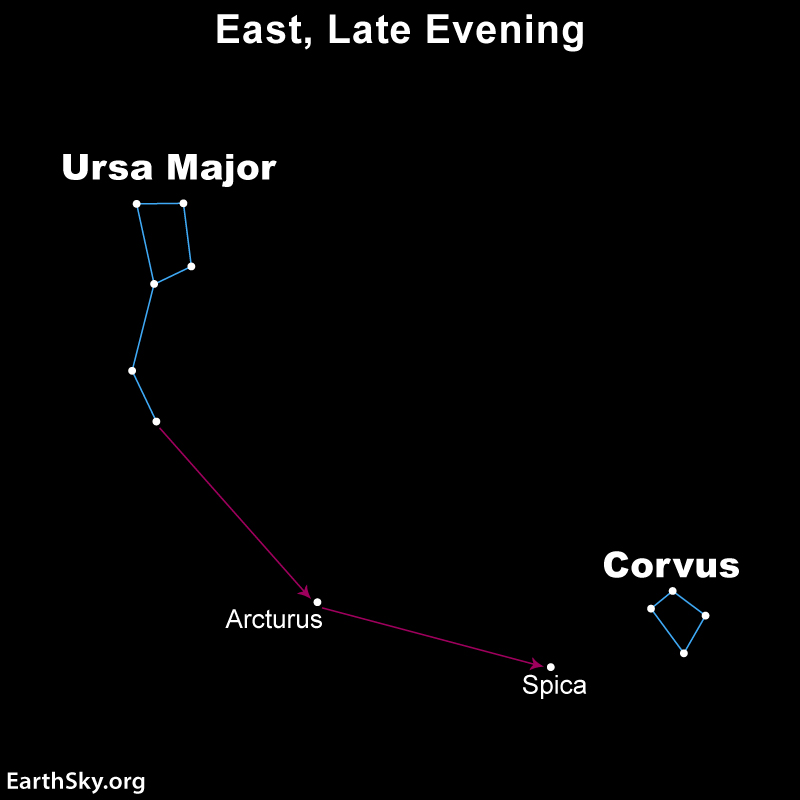
The stars of the Maiden
Spica, which marks a bundle of wheat that the Maiden is holding, is the 15th brightest star in the sky. Spica is a magnitude 1.04 star that lies 250 light-years from Earth.
Then the next brightest star in Virgo is the binary star Gamma Virginis, or Porrima. Porrima is magnitude 2.74 and lies near the center of the constellation, above (northwest of) Spica. It lies 38 light-years away. Next, the third brightest star is at the northern reaches of the constellation. Vindemiatrix is a magnitude 2.82 star located 109 light-years away.
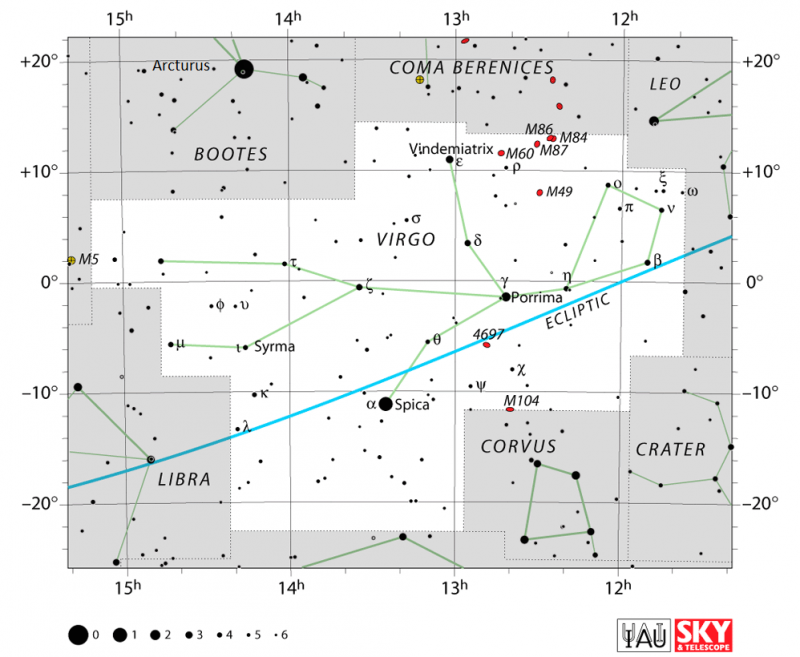
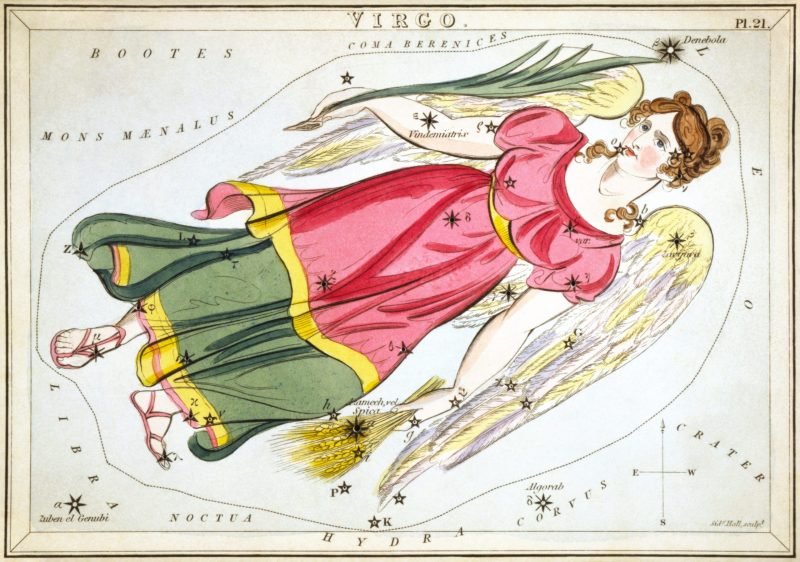
The Virgo Cluster
Without a doubt, Virgo is famous for its thousands of galaxies. One grouping – the Virgo Cluster – is near the border with Coma Berenices, west of Vindemiatrix. The Virgo Cluster is the nearest large group of galaxies to the Milky Way. The Virgo Cluster lies at the center of the Local Supercluster, a massive group of clusters of galaxies. Plus, the Local Group of galaxies, which includes the Milky Way, is also part of the Local Supercluster.
Additionally, the gravitational pull from the Virgo Cluster in the Local Supercluster is slowing the escape velocity of the Milky Way and our Local Group. So the Virgo cluster is one of the few places in the universe we are speeding toward. Therefore, the galaxies of the Virgo Cluster are some of the few we see with a blueshift instead of a redshift. One day, these many galaxies will merge into one huge conglomeration.
In fact, the galaxy with one of the highest blueshifts lies right on the border of Virgo and Coma Berenices. This galaxy, M90, is moving rapidly among the other objects in the Virgo Cluster. That’s because it’s also being stripped of gas and dust due to its close quarters with the other galaxies. At magnitude 9.5, you can see this galaxy in a telescope across the 60 million light-year span.
In addition, other galaxies between 8th and 9th magnitude in this location are M49, M58, M59, M60, M84, M86, M87, and M89. Even more galaxies come into view if you scan along the line between Virgo and Coma Berenices.
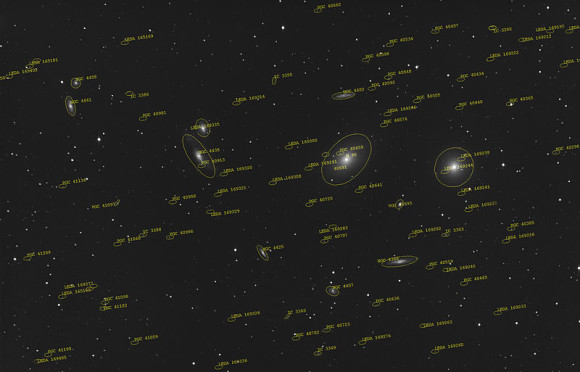
M87, or Virgo A
M87 is a special galaxy that deserves to be singled out from the Virgo Cluster. It shines at magnitude 8.6 and is therefore easy to detect in any telescope and even in some binoculars. M87 lies about 60 million light-years away. Its potato-shaped clump of stars extends well over a half million light-years across, and thought to be five times the size of the Milky Way’s diameter. However, the diameter of the galaxy’s halo is about a million light-years, and while that is large, astronomers expected it to be even larger. They believe something cut the halo off early on in its formation.
As a matter of fact, M87 is home to the largest known number of globular clusters. For comparison, the Milky Way has about 200 globulars, while M87 has thousands. These clusters may be dwarf galaxies that M87’s gravitation sucked in.
Another amazing feature of M87 is its jet that extends outward from the core for thousands of light-years. A monster black hole at the galaxy’s core is the source of the jet. In fact, M87’s black hole was the first ever imaged, in 2019. Then, recently that image was enhanced and released with more detail in April 2023. Plus, its black hole and its jet were imaged together for 1st time ever in April 2023.

The Sombrero Galaxy
Not to be overlooked is another bright and notable galaxy that’s apart from the large cluster is M104, or the Sombrero Galaxy. It’s located on the southeastern border of the constellation with Corvus the Crow. Without a doubt, M104 is a stunning galaxy in photographs. Even better, at magnitude 8.3, you can see it in small telescopes. It’s an edge-on, dusty spiral galaxy with a bright core. M104 lies approximately 55 million light-years away.
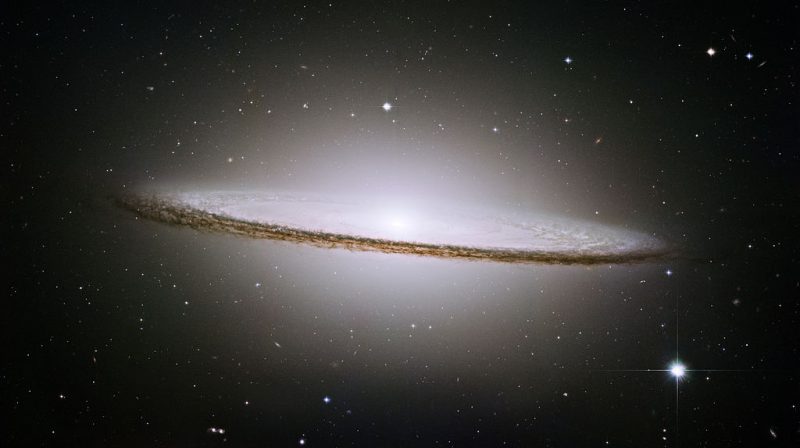
Virgo in mythology
The constellation Virgo is linked to the myth of Demeter, the harvest goddess, and her daughter Persephone. According to the myth, it once was always springtime on Earth. But then the god of the underworld, Hades, kidnapped Persephone.
Demeter, overcome with grief, abandoned her role as an Earth goddess. The world’s fruitfulness and fertility suffered. So Zeus insisted that Hades return Persephone to Demeter. But Zeus set a condition. He said Persephone must not eat until she returned to her home. That’s when Hades gave Persephone a pomegranate. It’s said that Persephone ate just six seeds.
So Persephone returned to her mother. But – because of the pomegranate – she has to return to the underworld for half of every year. To this day, spring returns to the Northern Hemisphere when Persephone reunites with Demeter. Then the winter season reigns when Persephone dwells in the underworld. Considering this, from the perspective of the Northern Hemisphere, Virgo is absent from early evening sky in late autumn, winter and early spring. Virgo’s return to the sky at nightfall – in the months of April and May – coincides with the season of spring.
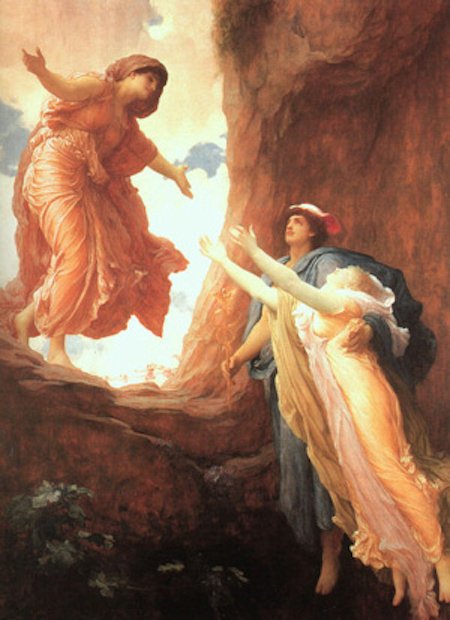
The constellations of the zodiac
Meet Taurus the Bull in the evening sky
Gemini the Twins, home to 2 bright stars
Meet Cancer the Crab and its Beehive Cluster
Leo the Lion and its backward question mark
Virgo the Maiden in northern spring skies
Meet Libra the Scales, a zodiacal constellation
Scorpius the Scorpion is a summertime delight
Sagittarius the Archer and its famous Teapot
Capricornus the Sea-goat has an arrowhead shape
Meet Aquarius the Water Bearer and its stars
Meet Pisces the Fish, 1st constellation of the zodiac
Say hello to Aries the Ram
Born under the sign of Ophiuchus?
Bottom line: Virgo the Maiden is the largest of the zodiac constellations. A handy mnemonic device – using the Big Dipper and its bright star Spica – make it easy to find.











